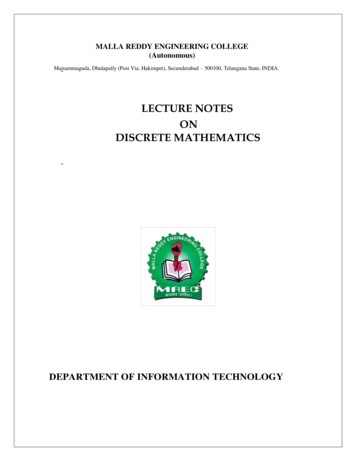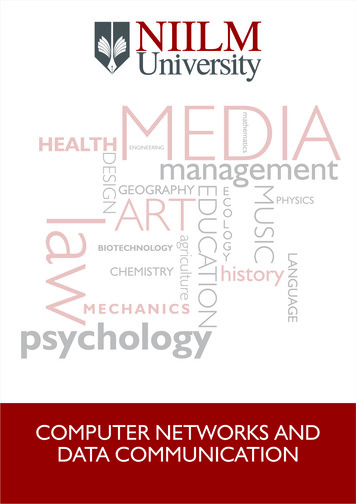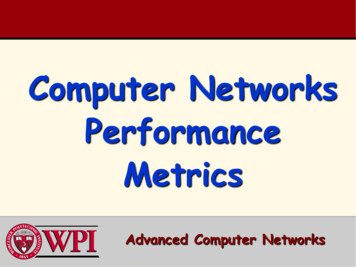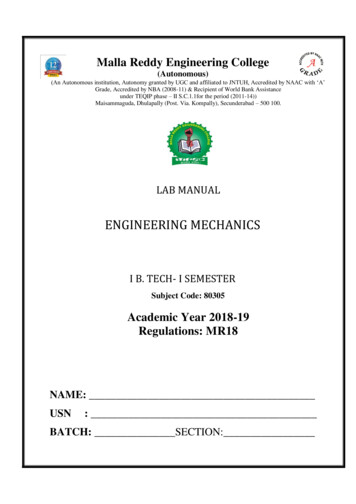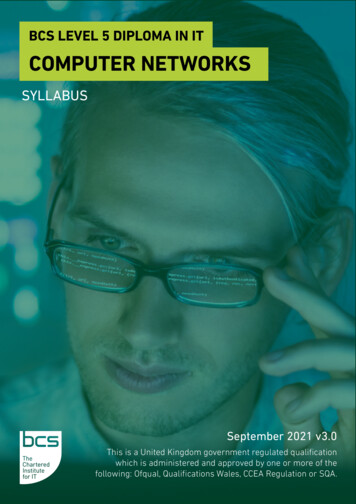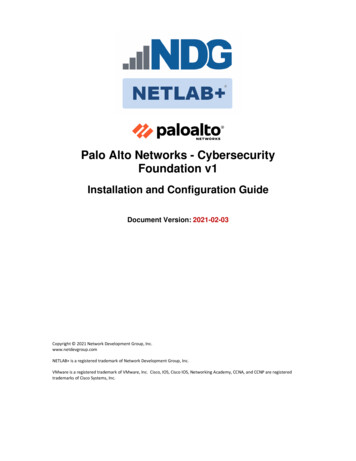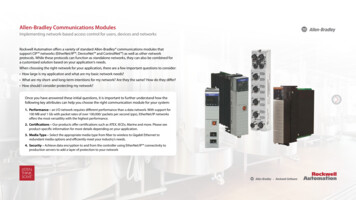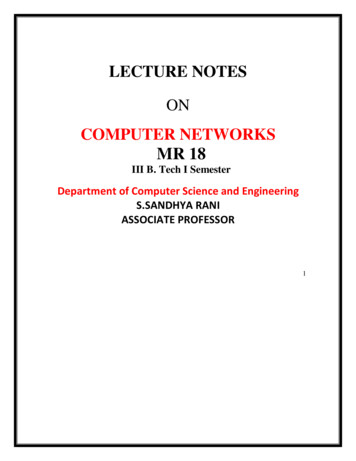
Transcription
LECTURE NOTESONCOMPUTER NETWORKSMR 18III B. Tech I SemesterDepartment of Computer Science and EngineeringS.SANDHYA RANIASSOCIATE PROFESSOR1
2018-19Onwards(MR-18)MALLA REDDY ENGINEERING COLLEGE(Autonomous)Code: 80517B.Tech.V SemesterLTP3--COMPUTER NETWORKSCredits: 3Course objectives: This course provides students to understand the fundamentalconcepts of computer networking and communications make use of IEEE standardsin the construction of LAN, build the skills of subnetting and supernetting, explainthe concepts of protocols of Transport Layer, QoS and Congestion controlmechanisms and demonstrate different protocols of Application Layer.MODULE I: Basics of Networking and Physical layer[10 Periods]Basics of Networking - Components – Direction of Data flow – Networks –Components and Categories – Types of Connections – Topologies –Protocols andStandards – ISO / OSI model, TCP/IP model.Physical layer - Digital transmission, Multiplexing, Transmission Media, Switching,Circuit Switched Networks, Datagram Networks, Virtual Circuit Networks.MODULE II: Data link layer[11 Periods]Functionalities of Data link layer - Introduction, Framing, Error Detection andCorrection – Parity – LRC – CRC- Hamming code, Flow and Error Control,Noiseless Channels, Noisy Channels, HDLC, Point to Point Protocols. Randomaccess, Controlled access, Channelization, Collision Free Protocols.LAN - LAN - Ethernet IEEE 802.3 - IEEE 802.4 - IEEE 802.5 - IEEE 802.11MODULE III: Network Layer[09 Periods]A: Basics of Network Layer - Logical Addressing, Internetworking, Tunneling,Address mapping,B: Communication Protocols - ICMP, IGMP, Forwarding, Unicast RoutingProtocols, Multicast Routing Protocols.MODULE IV: Transport Layer[09 Periods]Connection Oriented and Connectionless Protocols -Process to Process Delivery,UDP and TCP protocols, SCTP.Congestion Control - Data Traffic, Congestion, Congestion Control, QoS,Integrated Services, Differentiated Services, QoS in Switched Networks.MODULE V: Application layer[09 Periods]DNS - Domain name space, DNS in internet, Electronic mailProtocols and Network Security - FTP, WWW, HTTP, SNMP, Network Security,Cryptography.TEXT BOOKS:1. Behrouz A. Forouzan, “Data Communications and Networking”, 4thEdition,TMH, 2006.2. Andrew S Tanenbaum, “Computer Networks”, 4th Edition, PearsonEducation/PHI.
REFERENCES:1. P.C .Gupta, “Data communications and computer Networks”, PHI.2. S.Keshav, “An Engineering Approach to Computer Networks”, 2nd Edition, Pearson Education.3. W.A. Shay, “Understanding communications and Networks”, 3rd Edition, CengageLearning.4. James F.Kurose & Keith W. Ross, “Computer Networking: A Top-Down Approach Featuring theInternet”, 3rd Edition, Pearson Education.E-RESOURCES:1. 2/02/Computer-Networking- Principles- Bonaventure-1-30-31OTC1.pdf2. http://ebook-dl.com/downloadbook/2303. https://doi.org/10.1016/0169-7552(89)90019-64. http://nptel.ac.in/courses/106105081/Course Outcomes:At1.2.3.4.5.COsthe end of the course, students will be able toUnderstand the Layered Architecture of Computer Networks.Conceptualize the protocols of Data Link Layer and can build Local area networks.Apply Subnet and Supernet concepts in the construction of computer network.Summarize the protocols used in Transport Layer, QoS and Congestion control mechanisms.Analyze different protocols of Application Layer and various security risks.CO- PO, PSO Mapping(3/2/1 indicates strength of correlation) 3-Strong, 2-Medium, 1-WeakProgramme O12PSO132CO1CO2CO3CO4CO5PO3PSO2PSO32233232Computer NetworksS.SANDHYARANI
UNIT- IIntroductionAn interconnected collection of autonomous computers is called a computer network. Twocomputers are said to be interconnected if they are able to exchange the information. If onecomputer can forcibly start, stop and control another one, the computers are not autonomous. Asystem with one control unit and many slaves is not a network, nor is a large computer withremote printers and terminals.In a Distributed system, the existence of multiple autonomous computers is transparent(i.e., notvisible) to the user. He can type a command to run a program and it runs. It is up to the operatingsystem to select the best processor, find and transport all the files to that processor, and put theresults in the appropriate place.The user of a distributed system is not aware of that there are multiple processors; it looks like avirtual uniprocessor. Allocation of jobs to processors and files to disks, movement of files betweenwhere they are stored and where they are needed, and all system function are automatic.With a network, users must explicitly log onto one machine, explicitly submit jobs remotely,explicitly move files around and generally handle all the network management personally. Thedistinction between Network and distributed system lies with software (OS) rather than software.In network user invokes, in distributed system the system invokes.A network is a set of devices connected by media links. Anode can be a computer, printer or anyother device capable of sending and receiving data generated by other nodes on the network.The links connecting the devices are often called communication channels.Networks use Distributed processing, in which a task is divided among multiple computers.Advantages of Distributed processing are Security/ Encapsulation Distributed data bases Faster problem solving Security through Redundancy Collaborative processingNetwork CriteriaComputer NetworksS.SANDHYARANI
Network The performance can be measured in many ways and depends on number of factors. Number of usersType of transmission mediumHardwareSoftwareReliabilityThis is measured by the following factors Frequency of failure Recovery time of a network after a failure. Catastrophe.SecurityNetwork security issues include protecting data from the following Unauthorized access VirusesApplications Accessing Remote databases Accessing Remote programs Value added communication facility Marketing and sales Financial services Manufacturing Electronic message Directory services Information services Teleconferencing Cellular telephone Cable televisionComputer NetworksS.SANDHYARANI
Network StructureHostsIMPSubnetThe end systems are called the HOSTS. The hosts are connected through acommunication subnet or simply Subnet as shown in fig.The subnet consists of two parts: a) Transmission lines b) Switching elements.The Transmission lines transmit the raw bits. The Switching elements are specializedcomputers, which switches packets. This is called Interface Message Processor (IMP) orRouter or data switching exchanges or packet switching nodes.The data can be transmitted through the subnet in two ways. They area) Point to point or store and forwardb) Broad castingNetwork ArchitectureTo reduce the design complexity, most networks are organized as a series of layers orlevels, each built upon on the one below it. The number of layers, the name of each layer,the contents of each layer ,and the function of each layer differ from network to networkHowever, in all networks the purpose of each layer is to offer certain services to the higherlayers ,shielding those layers from the details of how the offered services are actuallyimplemented.Computer NetworksS.SANDHYARANI
Layer n on one machine carries on a conversation with layer n on another machine. Therules and conventions used in this conversation are collectively known as the layer nProtocol.The entities comprising the corresponding layers on different machines are called Peers.Layer 5Layer 5 protocolLayer 5Layer 4/5 interfaceLayer 4 protocolLayer 4Layer 4Layer 3/4 interfaceLayer 3Layer 3 protocolLayer 3Layer 2/3 interfaceLayer 2Layer 2 protocolLayer 2Layer 1/2 interfaceLayer 1 protocolLayer 1Layer 1Physical MediumLayers, protocols and interfaces.The interface defines which primitive operation and services the lower layer offers to theupper one.A set of layers and protocol is called network architecture.Data transfer methods:a. Simplex communication:Data will be transferred in one direction only.Simplex transmissionABEx: Keyboards, Monitorsb. Half -- duplex communication:Data will be transferred in both the directions, but not simultaneously.Computer NetworksS.SANDHYARANI
Half duplex transmissionABEx: One way bridge with two directional traffic.c. Full – duplex communication:Data will be transferred in both the directions simultaneously.ABEx: Two-way road, where traffic will be there in both the directions.REFERENCE MODELSThe ISO OSI REFERENCE MODELIn 1947, the International Standards Organization (ISO) proposed a network model that covers allnetwork communications .This model is called Open Systems Interconnection (OSI) model. Anopen system is a model that allows any two different systems to communicate regardless of theirunderlying architecture.The OSI model is built of seven layers: Physical (layer 1), Data link (layer 2), Network(layer 3), Transport (layer 4), Session (layer 5), Presentation (layer 6) and Application layers(layer 7).Within a single machine, each layer calls upon the services of the layer just below it.layer 3,forexample, uses the services provided by layer 2 and provides for layer 4.Between machines layeron one machine communicates with layer x on another machine. This communication is governedby protocols. The processes on each machine that communicate at a given layer are called peer–to – peer processor.At the physical layer, communicate is direct: Machine A sends a stream of bits to machine B. Atthe higher layers, however, communication must move down through the layers on machine A,over to machine B, and then back up through the layers. Each layer in the sending machine addsits own information to the message it receives from the layer just above it and passes the wholepackage to the layer just below it. This information is added in the form of headers or trailers.Headers are added to the message at layers 6, 5, 4, 3, and 2.At layer 1 the entire messageconverted to a form that can be transferred to the receiving machine. At the receiving machine,Computer NetworksS.SANDHYARANI
the message is unwrapped layer by layer, with each process receiving and removing the datameant for it.Organization of the layers:The seven layers can be thought of as belonging to three subgroups. Layers 1, 2, 3 –are thenetwork support layers; they deal with the physical aspects of moving data from onr machine toanother. Layers 5, 6, 7—can be thought of as user support layers: they allow interoperabilityamong unrelated software systems. Layer 4,the transport layer, ensures end to end reliabletransmission while layer 2 ensures reliable transmission on a single link. The upper layers areimplemented almost always in software; lower layers are a combination of hard ware andsoftware, where as physical layer is mostly hardware.Name of unitexchangedLayerApplication protocol7Presentation onPresentationSession protocol5SessionSessionTransport protocol4Transport3Network21Data linkPhysicalTransportNetworkNetworkData linkData linkPhysicalPhysicalHost AData linkPhysicalHost BThe OSI reference modelComputer NetworksNetworkS.SANDHYARANI
FUNCTIONS OF LAYERS:Functions of the LayersPhysical Layer : Physical characteristics of interfaces and media Representation of bits. Data rate Synchronisation of bits Line configuration (point to point or multipoint) Transmission Mode Physical TopologyData Link Layer : Framing Physical addressing Error control Flow control Access controlNetwork Layer :- Routing- Congestion control- BillingTransport Layer :- Service – Point addressing- Segmentation and reassembly-Flow control-Error controlSession Layer :-Dialog control-SynchronizationPresentation Layer :- Data encoding- Encryption- CompressionComputer NetworksS.SANDHYARANI
Application Layer :-File Transfer- Mail services- Directory servicesTCP/IP reference t present inthe modelSessionTransportTransportNetworkNetworkData linkData linkPhysicalPhysicalSwitching MethodsTwo different types of switching methods are used: Circuit switching and Packet switching.Circuit SwitchingIn this switching there are three phasesa. Circuit establishmentb. Data transferc. Circuit disconnectionB23157A4C6DRepresents the nodeThe network stationComputer NetworksS.SANDHYARANI
Suppose if we want to send the data, say, from A to D. before sending the data a circuit will beestablished between A to D as shown in fig with doted lines. All the data will follow the same path.After data is transferred the circuit will be disconnected.Circuit switchingVirtual packet switchingPropagation delayPropagation delaycall accept signalcall accept signalP1P2DATAP3Ack signalAck21341123234P1Packet switchingP2P3Computer NetworksS.SANDHYARANI4signal
Packet switching will be done in two ways.1. Virtual Packet switching2. Data gram Packet switchingCircuit switchingData gram packetDedicated transmissionNo dedicated pathContinuous transmission ofdataTransmission of packetsVirtual packetNo dedicated pathTransmission of packetsMessages are not storedPackets are storedPackets are storeddelivereduntilPath will be established forentire conversationFixed bandwidth transmissionRoute will be established foreach packet.Dynamic use of bandwidthRoute will be established forentire conversationDynamic use of bandwidthX.25X.25 is a packet switching wide area network.It is an interface between DCE and DTE for terminal operation in the packet mode on public datanetworks.It defines how a packet- mode terminal connected to a packet network for the exchange of data.It describes the procedures for establishing maintaining and terminating connections.X.25 is known as a subscriber network interface (SNI).It defines how the user’s DTE communicates with the network and how packets are sent over thatnetwork using DCE’s.X.25 has three layers: Physical layer Frame layer and Packet layerPhysical Layer:At the physical layer, X.25 specifies a protocol called X.21.This is similar to other physical layer protocols.Computer NetworksS.SANDHYARANI
Frame Layer:X.25 provides data link control using a bit oriented protocol called link access procedure balanced(LAPB).Packet Layer:The Network layer in x.25 is called the Packet Layer Protocol (PLP). This layer is responsible for establishing the connection, transferring data and terminatingthe connection. It is also responsible for creating the virtual circuits and negotiating network servicesbetween two DTEs. The Frame layer is responsible for making a connection between a DTE and DCE, thePacket layer is responsible for making a connection between two DTEs. End-to-End flow and error control between two DTEs are under the jurisdiction of thePacket Layer.Examples of NetworksNOVEL NETWAREThe most popular network in pc world system is novel netware.it was designed to be used bycompanies from a mainframes to a network of PCs.1. In this system, each user has a desk top PC functioning as a client.2. Some number of power full PCs operate as servers providing file services ,data baseservices and other services to a collection of clients it uses a proprietary protocol.3. It is based an old Xerox network system, XNS with various modifications. Because of fivelayers, it looks much like TCP/IP than ISO OSI.4. Physical and data link layer can choose an Ethernet, IBM token ring and ARC net protocols.5. The network layer runs an unreliable connectionless Internet work protocol called ARC netprotocols.6. It passes packets from source to destination transparently; even both are of differentnetworks.7. Application layer uses SAP (Service Advertising protocol), to broadcast a packet and tellwhatComputer NetworksS.SANDHYARANI
service it offered. These packets are collected by special agents of a process running on therouter machine. With this information they construct databases of which server are runningwhere.8. When client machine is booted, it broadcast s a request asking where the nearest server is.The agent on the local router sees, looks into the database of servers and matches up therequest with the best server; with this the client can now establish a NCP connection and actlike client-server model in all aspects.Integrated Services Digital Network (ISDN)ISDN was developed by ITU- T in 1976.It is a set of protocols that combines digital telephony anddata transport services. The whole idea is to digitize the telephone network to permit thetransmission of audio, video, and text over existing telephone lines.The goal of isdn is to form a wide network that provides universal end –to – end connectivity overdigital media. This can be done by integrating all of the separate transmission services into onewithout adding links or subscriber lines.HISTORYVoice Communication over Analog NetworksInitially, telecommunications networks were entirely analog networks and were used for thetransmission of analog information in the form of voice.Voice and Data Communication over Analog NetworksWith the advent of digital processing, subscribers needed to exchange data as well as voice.Modems were developed to allow digital exchange over analog lines.Analog and Digital services to SubscribersTo reduce cost and improve performance, the telephone companies gradually began to adddigital technologies while continuing their analog services to their customers.Computer NetworksS.SANDHYARANI
Integrated Digital Network (IDN)Next, customers began to require access to a variety of networks, such as packet- switchednetworks and circuit –switched networks. To meet these needs the telephone companies createdIntegrated Digital Network (IDN). An IDN is a combination of networks available for differentpurposes.Integrated Services Digital Network (ISDN)The ISDN integrates customer service with the IDN. With ISDN all customers’ services becomedigital rather than analog and will allow the customers services to be made available on demand.SERVICESThe purpose of the ISDN is to provide fully integrated digital services to users. These services fallin to three categories: bearer services, teleservices, and supplementary services.Bearer serviceBearer services provide the means to transfer information (voice, data, and voice) between userswithout the network manipulating the content of information.Tele ServiceIn teleservices the network may change or process the contents of the data. These servicescorrespond to layers 4 – 7 of the OSI ISO model. this service include telephony,telefax,videotex,telex and teleconferencing.Supplementary serviceSupplementary services are those services that provide additional functionality to the bearerservice and teleservices. These services include call waiting, reverse charging, and messagehandling.Computer NetworksS.SANDHYARANI
SupplementaryservicesTele ServicesTelephonyTelefaxTelex Teletex Reversecharging Teleconferencing CircuitswitchingPacketswitching. - CallwaitingCellswitchingMessageHandlingBearer ServicesSUBSCRIBER ACCESS TO THE ISDNTo allow flexibility, digital pipes between customers and the ISDN office are organized intomultiple channels of different sizes. The ISDN standard defines three channel types, each with adifferent transmission rate: bearer channels, data channels, and hybrid channelsChannel RatesChannelBearer (B)Data (D)Hybrid (H)Data Rate(Kbps)6416,64384,1536,1920B ChannelA B channel is defined at a rate of 64 Kbps .It is the basic user channel and can carry any type ofdigital information in full duplex mode as long as the required transmission rate does not exceed64 Kbps. A B channel can be used to carry digital data, digitized voice, or other low data – rateinformation.D ChannelA D channel can be either 16 or 64 Kbps, depending on the need of the user. The primaryfunction of a D channel is to carry control signaling for the B channels. A D channel carries theComputer NetworksS.SANDHYARANI
control signaling for all the channels in a given path, using a method called common – channel(Out – of – band) signaling.Less common uses for the D channel include low- rate data transfer and applications such astelemetry and alarm transmission.H ChannelH Channels are available with data rates of 384 Kbps (HO), 1536 Kbps (H11), or 1920(H12).These e rates suit for high data rate applications such as video, teleconferencing and so on.Integrated Services Digital NetworkI SDNIntegrated services digital tchingOfficeSubscriber loops .User InterfacesDigital subscriber loops are two types: basic rate interface (BRI ) and primary rate interface(PRI ) .Each type is suited to a different level of customer needs .Both include one D channel andsome number of either B or H channels.BRIThe basic rate interface specifies a digital pipe consisting of two B channels and one 16Kbps Dchannel.To ISDN office64(B1) 64 (B2) 16( D) 48(over head) 192KbpsComputer NetworksS.SANDHYARANI
BRI requires a digital pipe of 192 Kbps as shown in the fig. Conceptually, the BRI service is like alarge pipe that contains three smaller pipes, two for the B channels and one for D channel. Theremainder of the space inside the large pipe carries overhead bits required for its operation.The BRI is designed to meet the needs of residential and small – office customers.PRIThe usual PRI specifies a digital pipe with 23 B channels and one 64 Kbps D channel.To ISDN officeP R I 1.544 Mbps64 x 23 (B1 – B23) 64 (D) 8 (overhead)PRI requires a digital pipe of 1.544 Mbps. Conceptually, the PRI services is like a large pipecontaining 24 smaller pipes, 23 for the B channels and for the D channel. The rest of the pipecarries the overhead bits.One PRI can provide full – duplex transmission between as many as 23 sources andreceiving nodes. The individual transmission are collected from their source and multiplexed on toa single path for sending to the ISDN office.Functional GroupingFunctional Grouping used at the subscriber’s premises includes network terminations, terminalequipment and terminal adapters, enables users to access the services of the BRI and PRI.Network Teriminator 1 ( NT1)An NT1 device controls the physical and electrical termination of the ISDN at user’s internalsystem to the digital subscriber loop. These functions are comparable to those defined for the OSIphysical layer.An NT1 organizes the date stream from connected subscribers into frames that can be sentover the digital pipe, and translates the frame received from the network into a format usable bythe subscriber’s device.Network Teriminator 2 ( NT2)A NT1 device performs functions at the physical layer, data link, and net work layers of the OSImodel.NT2 provide multiplexing (layer 1),flow control (layer 2), and packetzing (layer 3).An NT2provides intermediate signal processing between the Data – generating devices and anNT1.There must be a point to point connection between an NT1 and NT1 .NT2s are usedprimarily to interface between a multi-user system and an NT1 in a PRI.NT2s can be implemented by a variety of equipment types like a private branch exchange(digital PBX), a LAN can function as an NT2.Computer NetworksS.SANDHYARANI
Terminal Equipment 1 (TE1)The TE is used by ISDN in the same manner as DTE in other protocol. Examples of TE1 aredigital telephones, integrated voice/data terminals, digital facsimiles.Terminal Equipment 2 (TE2)To provide backward compatibility with a customer’s existing equipment, the ISDN standarddefines a second level of terminal equipment called Terminal Equipment 1 ( TE1 ).This is a nonISDN device, such as terminal, workstation or regular telephone. This can be used with the helpof another device called a terminal adapter (TA).Reference PointsThis refers to the label used to identify individual interface between two elements of an ISDNinstallation. There are four reference points that defines the interface between a subscriber’sequipment and the network. They are R, S, T and U.Reference Point R defines the connection between a TE2 and a Ta. Reference Point S definesthe connection between a TE1 or TA and an NT1 or NT2. Reference Point T defines the interfacebetween an NT2 and NT1. Reference Point U defines the interface between an NT1 and theISDN office.RTE2SUTATo ISDNOfficeNT1SSUTE1To ISDNOfficeNT1STUTo ISDNTE1Computer NetworksNT2S.SANDHYARANINT1Office
Reference PointsThe ISDN LayersSince the ISDN specifies two different channels ( B and D) with different functionalities ,unlike theISO OSI (which has seven layers) the ISDN is defined in three separate planes : the user plane,the control panel ,and the management plane. All three planes are divided into seven layersthat correspond to the OSI model.B channelD channelUser’s choiceLayers 4,5,6,7NetworkX.25 and othersCall controlQ.931Data linkLAPB and othersLAPDPhysicalBRI (I.430) & PRI (I.431)Simplified layers of ISDNPhysical LayerThe ISDN physical layer specifications are defined by two ITU-T standards: L430 for BRI accessand I.431 for PRI access. These standards define all aspects of the BRI and PRI. Of theseaspects, four are of primary importance: The mechanical and electrical specifications of interfaces R, S, T and U. Encoding Multiplexing channels to make them carriable by the BRI and PRI digital pipe. Power supply Data Link LayerB and D channels use different data link protocols. B channels use LAPB protocol. The D channeluses link access procedure for D channel (LAPD).Network LayerOnce a connection has been established by the D channel, the B channel sends data using circuitswitching, X.25,or other similar protocols. The network layer packet is called a message.Computer NetworksS.SANDHYARANI
BROAD BAND ISDNWhen the ISDN was originally designed data rates of 64 Kbps to 1.544 Mbps were sufficient tohandle all existing transmission needs. As applications using the telecommunications networkadvanced, however, these rates proved inadequate to support many applications. In addition, theoriginal bandwidths provided too narrow to carry the large numbers of concurrent signalsproduced by a growing industry of digital services providers.To provide for the needs of the next generation of technology, an extension of ISDN,called broadband ISDN is under study. B-ISDN provides subscribers to the network with datarates in the range of 600 Mbps, almost 400 times faster than the PRI rate.ServicesB-ISDN provides two types of services: interactive and distributive.Interactive servicesInteractive services are those that require two-way exchanges between either two subscribers orbetween a subscriber and a service provider. These services are of three types: conversational,messaging and retrieval.ConversationalThese services are those, such as telephone calls, that support real time exchanges. These realtime services can be used for telephoning, video telephoning, and video conferencing, datatransfer.MessagingThese services stored and forward exchanges. These are bi-directional, meaning that all partiesin an exchange can use them at same time. These services include voice mail, data mail, videomail.RetrievalThese services are those used to retrieve information from a central source called an informationcenter. These services are like libraries; they must allow public access to retrieve information ondemand. And information is not distributed unless asked for.Distributive servicesThese services are unidirectional services sent from a provider to subscribers without thesubscriber having to transmit a request each time a service is desired. These services can bewithout or with user control.Access methodB-ISDN defines three access methods to provide for three levels of user needs. They are: 155.520 Mbbs full duplex symmetrical 622.080 Mbbs full duplex 155.520 Mbbs asymmetrical *Computer Networks**S.SANDHYARANI**
Expected Questions1. Describe ISO OSI model with a neat sketch.2. Compare and contrast the ISO OSI model with TCP/IP model.3. Explain Novel NetWare and the ARPANET.4. Explain the working of X.215. Explain this network structure6. Explain different types of transmission media used in data communication7. Give advantages and disadvantages of fiber optic cable over metallic cable8. Draw the B-ISDN reference model and explain the functions of each layer.9. Explain about ATM. What are the advantages of using fixed length cells.10. Explain X.25 network.11. What are the applications of networks?12. Write the difference between B-ISDN and N-ISDN13. Explain the following itemsa) IMPb) HOSTc) Subnet14. What are the advantages of layered architecture15. Explain the goals of a computer network.***************************Computer NetworksS.SANDHYARANI
Review Questions1. Which OSI layers are the network support layers?2. Which OSI layers are the user support layers?3. What is the difference between network layer delivery and transport layer delivery?4.List the layers of the OSI model.5. What is a peer-to-peer process?6. How does information get passed from one layer to the next?7.What are the concerns of the Physical Layer?8. What are the responsibilities of the data link layer?9. What are the responsibilities of the network layer?10. What are the responsibilities of the transport layer?11. The transport layer creates a connection between the source and destination. What are thethree events involved in a connection?12. What are the responsibilities of the session layer?13. What are the responsibilities of the presentation layer?14. What are the services provided by the application layer?15.Name two categories of transmission media.16.How do guided media differ from unguided?17.What are the three major classes of guided media.18.What is the major advantage of shielded twisted pair over uns
Computer Networks S.SANDHYA RANI UNIT- I Introduction An interconnected collection of autonomous computers is called a computer network. Two computers are said to be interconnected if they are able to exchange the information. If one computer can forcibly start, stop and control another one, the computers are not autonomous. A

